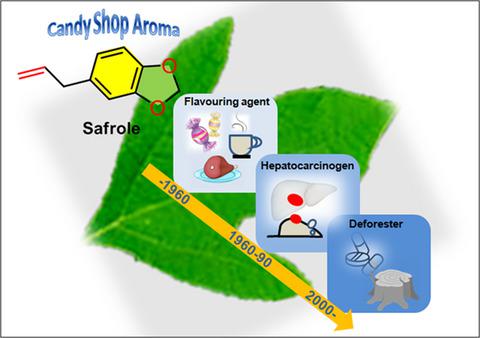当前位置:
X-MOL 学术
›
Flavour Frag. J.
›
论文详情
Our official English website, www.x-mol.net, welcomes your feedback! (Note: you will need to create a separate account there.)
Review on safrole: identity shift of the ‘candy shop’ aroma to a carcinogen and deforester
Flavour and Fragrance Journal ( IF 2.6 ) Pub Date : 2019-08-01 , DOI: 10.1002/ffj.3521 Phirose Kemprai 1, 2 , Bhaskar Protim Mahanta 1, 2 , Dristi Sut 1, 2 , Rubi Barman 1, 2 , Dipanwita Banik 1 , Mohan Lal 1 , Siddhartha Proteem Saikia 1 , Saikat Haldar 1
Flavour and Fragrance Journal ( IF 2.6 ) Pub Date : 2019-08-01 , DOI: 10.1002/ffj.3521 Phirose Kemprai 1, 2 , Bhaskar Protim Mahanta 1, 2 , Dristi Sut 1, 2 , Rubi Barman 1, 2 , Dipanwita Banik 1 , Mohan Lal 1 , Siddhartha Proteem Saikia 1 , Saikat Haldar 1
Affiliation

|
Safrole, a phenylpropene with a ‘candy shop’ aroma, is abundant in nature among diverse plant genera such as Sassafras, Ocotea, Cinnamomum, Myristica, and Piper. Sassafras oil has been used extensively for a long time, first by Native Americans and later by European settlers in traditional medicine and as a flavouring agent. Until 1960 the consumption of safrole by the western population, as a flavouring agent in beer, meat, and soft drinks, was unregulated. Later, the recognition of this phytochemical as a weak hepatocarcinogen with demonstrated genotoxicity in rodents led to strict restrictions on its use in food by various regulatory bodies globally. Moreover, in Asian countries oral carcinogenesis has been linked to safrole through the habit of chewing betel quid. As a separate issue, safrole is an inexpensive synthetic precursor to the illicit recreational drug Ecstasy. Accelerating demand for this party drug during the last few decades has encouraged the unscientific harvesting, illegal production, and trading of safrole‐rich oils, leading to massive deforestation. Recently, many government authorities have enforced laws to restrict the production and harvesting of safrole‐bearing plants. Thus, the identity of safrole has altered with time from a pleasant flavouring agent to a hepatocarcinogen, and more recently as a driver of the destruction of biodiversity. Law enforcement has not only hampered its availability but has also extensively affected industrial use. Our review describes the research progress (1960–2018) on its natural distribution, carcinogenicity, usage as a natural synthon, and the regulations imposed on safrole and safrole‐rich oils worldwide. Finally, we draw our readers’ attention to the sustainable use of this phytochemical for a better future.
中文翻译:

关于黄樟脑的评论:“糖果店”香气的身份转移到致癌物和砍伐森林的人身上
舒芙乐是一种带有“糖果店”香气的苯丙烯,在自然界中丰富,如S树,Ocotea,肉桂,肉豆蔻和胡椒。assa石油已被广泛使用了很长一段时间,首先是美洲原住民,后来是欧洲定居者在传统医学中用作调味剂。直到1960年,西方人在啤酒,肉类和软饮料中作为调味剂的黄樟脑消费量都没有受到管制。后来,人们认识到这种植物化学物质是弱肝癌,并在啮齿动物中表现出遗传毒性,导致全球各种监管机构对其在食品中的使用进行了严格限制。此外,在亚洲国家,通过咀嚼槟榔的习惯,口腔致癌作用已与紫杉醇有关。作为一个单独的问题,黄樟脑是非法休闲药物摇头丸的廉价合成前体。在过去的几十年中,对这种方药的需求不断增长,这鼓励了不科学的收割,非法生产,和富含黄樟脑的油贸易,导致大规模的森林砍伐。最近,许多政府机构已经执行法律,限制了含有黄樟脑的植物的生产和收获。因此,随着时间的推移,黄樟脑的身份已经从令人愉悦的调味剂改变为肝癌致癌物,并且最近成为破坏生物多样性的驱动力。执法不仅阻碍了其可用性,而且还广泛影响了工业用途。我们的综述描述了其自然分布,致癌性,用作天然合成子的研究进展(1960年至2018年),以及对全球黄樟脑和富含黄樟脑的油脂实施的法规。最后,我们提请读者注意这种植物化学物质的可持续利用,以期拥有更美好的未来。许多政府机构已执行法律,限制了含有黄樟脑的植物的生产和收获。因此,随着时间的推移,黄樟脑的身份已经从令人愉悦的调味剂改变为肝癌致癌物,并且最近成为破坏生物多样性的驱动力。执法不仅阻碍了其可用性,而且还广泛影响了工业用途。我们的综述描述了其自然分布,致癌性,用作天然合成子的研究进展(1960年至2018年),以及对全球黄樟脑和富含黄樟脑的油脂实施的法规。最后,我们提请读者注意这种植物化学物质的可持续利用,以创造更美好的未来。许多政府机构已执行法律,限制了含有黄樟脑的植物的生产和收获。因此,随着时间的推移,黄樟脑的身份已经从令人愉悦的调味剂改变为肝癌致癌物,并且最近成为破坏生物多样性的驱动力。执法不仅阻碍了其可用性,而且还广泛影响了工业用途。我们的综述描述了其自然分布,致癌性,用作天然合成子的研究进展(1960年至2018年),以及对全球黄樟脑和富含黄樟脑的油脂实施的法规。最后,我们提请读者注意这种植物化学物质的可持续利用,以创造更美好的未来。随着时间的流逝,从令人愉悦的调味剂到肝癌致癌物质,黄樟脑的身份也发生了变化,并且最近成为破坏生物多样性的驱动力。执法不仅阻碍了其可用性,而且还广泛影响了工业用途。我们的综述描述了其自然分布,致癌性,用作天然合成子的研究进展(1960年至2018年),以及对全球黄樟脑和富含黄樟脑的油脂实施的法规。最后,我们提请读者注意这种植物化学物质的可持续利用,以期拥有更美好的未来。随着时间的流逝,从令人愉悦的调味剂到肝癌致癌物质,黄樟脑的身份也发生了变化,并且最近成为破坏生物多样性的驱动力。执法不仅阻碍了其可用性,而且还广泛影响了工业用途。我们的综述描述了其自然分布,致癌性,用作天然合成子的研究进展(1960年至2018年),以及对全球黄樟脑和富含黄樟脑的油脂实施的法规。最后,我们提请读者注意这种植物化学物质的可持续利用,以创造更美好的未来。我们的综述描述了其自然分布,致癌性,用作天然合成子的研究进展(1960年至2018年),以及对全球黄樟脑和富含黄樟脑的油脂实施的法规。最后,我们提请读者注意这种植物化学物质的可持续利用,以创造更美好的未来。我们的综述描述了其自然分布,致癌性,用作天然合成子的研究进展(1960年至2018年),以及对全球黄樟脑和富含黄樟脑的油脂实施的法规。最后,我们提请读者注意这种植物化学物质的可持续利用,以创造更美好的未来。
更新日期:2019-08-01
中文翻译:

关于黄樟脑的评论:“糖果店”香气的身份转移到致癌物和砍伐森林的人身上
舒芙乐是一种带有“糖果店”香气的苯丙烯,在自然界中丰富,如S树,Ocotea,肉桂,肉豆蔻和胡椒。assa石油已被广泛使用了很长一段时间,首先是美洲原住民,后来是欧洲定居者在传统医学中用作调味剂。直到1960年,西方人在啤酒,肉类和软饮料中作为调味剂的黄樟脑消费量都没有受到管制。后来,人们认识到这种植物化学物质是弱肝癌,并在啮齿动物中表现出遗传毒性,导致全球各种监管机构对其在食品中的使用进行了严格限制。此外,在亚洲国家,通过咀嚼槟榔的习惯,口腔致癌作用已与紫杉醇有关。作为一个单独的问题,黄樟脑是非法休闲药物摇头丸的廉价合成前体。在过去的几十年中,对这种方药的需求不断增长,这鼓励了不科学的收割,非法生产,和富含黄樟脑的油贸易,导致大规模的森林砍伐。最近,许多政府机构已经执行法律,限制了含有黄樟脑的植物的生产和收获。因此,随着时间的推移,黄樟脑的身份已经从令人愉悦的调味剂改变为肝癌致癌物,并且最近成为破坏生物多样性的驱动力。执法不仅阻碍了其可用性,而且还广泛影响了工业用途。我们的综述描述了其自然分布,致癌性,用作天然合成子的研究进展(1960年至2018年),以及对全球黄樟脑和富含黄樟脑的油脂实施的法规。最后,我们提请读者注意这种植物化学物质的可持续利用,以期拥有更美好的未来。许多政府机构已执行法律,限制了含有黄樟脑的植物的生产和收获。因此,随着时间的推移,黄樟脑的身份已经从令人愉悦的调味剂改变为肝癌致癌物,并且最近成为破坏生物多样性的驱动力。执法不仅阻碍了其可用性,而且还广泛影响了工业用途。我们的综述描述了其自然分布,致癌性,用作天然合成子的研究进展(1960年至2018年),以及对全球黄樟脑和富含黄樟脑的油脂实施的法规。最后,我们提请读者注意这种植物化学物质的可持续利用,以创造更美好的未来。许多政府机构已执行法律,限制了含有黄樟脑的植物的生产和收获。因此,随着时间的推移,黄樟脑的身份已经从令人愉悦的调味剂改变为肝癌致癌物,并且最近成为破坏生物多样性的驱动力。执法不仅阻碍了其可用性,而且还广泛影响了工业用途。我们的综述描述了其自然分布,致癌性,用作天然合成子的研究进展(1960年至2018年),以及对全球黄樟脑和富含黄樟脑的油脂实施的法规。最后,我们提请读者注意这种植物化学物质的可持续利用,以创造更美好的未来。随着时间的流逝,从令人愉悦的调味剂到肝癌致癌物质,黄樟脑的身份也发生了变化,并且最近成为破坏生物多样性的驱动力。执法不仅阻碍了其可用性,而且还广泛影响了工业用途。我们的综述描述了其自然分布,致癌性,用作天然合成子的研究进展(1960年至2018年),以及对全球黄樟脑和富含黄樟脑的油脂实施的法规。最后,我们提请读者注意这种植物化学物质的可持续利用,以期拥有更美好的未来。随着时间的流逝,从令人愉悦的调味剂到肝癌致癌物质,黄樟脑的身份也发生了变化,并且最近成为破坏生物多样性的驱动力。执法不仅阻碍了其可用性,而且还广泛影响了工业用途。我们的综述描述了其自然分布,致癌性,用作天然合成子的研究进展(1960年至2018年),以及对全球黄樟脑和富含黄樟脑的油脂实施的法规。最后,我们提请读者注意这种植物化学物质的可持续利用,以创造更美好的未来。我们的综述描述了其自然分布,致癌性,用作天然合成子的研究进展(1960年至2018年),以及对全球黄樟脑和富含黄樟脑的油脂实施的法规。最后,我们提请读者注意这种植物化学物质的可持续利用,以创造更美好的未来。我们的综述描述了其自然分布,致癌性,用作天然合成子的研究进展(1960年至2018年),以及对全球黄樟脑和富含黄樟脑的油脂实施的法规。最后,我们提请读者注意这种植物化学物质的可持续利用,以创造更美好的未来。


























 京公网安备 11010802027423号
京公网安备 11010802027423号